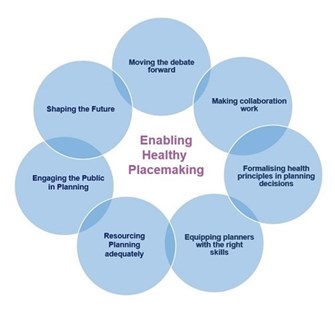Mental health importance in Urban cities
Mental health & Public spaces
The link between open spaces and mental health has been well established, particularly, green spaces. Studies have shown that people experience less mental distress, less anxiety and depression, greater well-being and healthier cortisol levels (the hormone that controls mood) when living in urban areas with more green space compared with less.
The built environment can have an impact on how successfully an individual can embed healthy behaviors, such as social interaction and active travel, into their lives. By taking this approach to healthy behavior’s and prevention it strengthens the arguments for a focus on healthy places to create good health now and in the future.

Fig. 1: Enabling Healthy Placemaking between planning, health and social care professionals
Designer’s approach to good mental health
There are four key principles which effectively improve the impact of Urban places on mental health.
- Green – access to natural settings in neighborhoods and the course of people’s daily routines through public/private gardens, livable streets and accessible and adaptable public spaces can improve and maintain mental health and wellbeing;
- Active – embedding opportunities for activity as part of day -to-day lives, with opportunities for exercise, social interactions, active travel and access to public transport can improve well-being, mental health and embed a sense of agency into daily routines;
- Pro-social – active co-production and stewardship of urban design that facilitates positive, safe and natural interactions among all people to promote an integrated sense of community, belonging and meaning;
- Safe – a sense of safety and security is integral to people’s mental health and well-being. Appropriate lighting and surveillance permeability, legibility, and people-centric design is important, plus high environmental quality and measures to reduce pollution, traffic and crime.

Fig. 2: Green, Active, Pro-social & Safe spaces
Planning for Mental health
here are many opportunities for town planners to integrate consideration of mental health into their work. A policy, plan or development may not directly set out to address mental health issues.
- Encouraging inclusive and connected communities;
- Creating a pedestrian friendly place;
- Introducing new greenspace;
- Protecting inner city access to greenspace;
- Refusing permission for isolated retirement housing;
- Restoring local pride;
- Temporary solutions to vacant sites.
Case study: Creating a pedestrian friendly place – Orford Road, Walthamstow Village, London
The project began in 2014, of transforming Orford road and neighboring roads, from busy streets to quiet back streets. The limitation of these streets has much-improved balance of people walking, cycling and using public transport. The success of the scheme in reducing vehicles journeys whilst improving business footfall, has resulted in its principles becoming mainstreamed in schemes across the borough and beyond.
The extensive community engagement has helped the local authority to work to continuously improve the scheme and to establish an innovative approach that can be replicated around the country at a time when there is a renewed focus on encouraging active travel and revitalizing neighborhood centres.

Fig. 2: Orford Road at the heart of Walthamstow Village
Conclusion
- Public mental health must be taken into consideration design spaces.
- Green spaces must be given importance.
- Outdoor places should be made more accessible to people.
- Improvement in design with respect to the need of people should be a mandate.
References:
Fig 1: Royal Town planning Institute, on Mental Health and Town Planning, Available at: https://www.rtpi.org.uk/practice/2020/october/mental-health-and-town-planning/#_ftn63
Fig 2 : Representation of urban spaces. Available at https://www.shiftspacedesign.com/portfolio/parklet/
Fig 3 : Orford Road at the heart of Walthamstow Village. Available at https://betterstreets.co.uk/waltham-forest-a-paradise-for-pedestrians/


